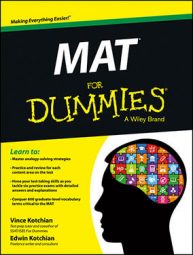The Miller Analogies Test (MAT) is a standardized test normally used for graduate school admissions. The test is composed entirely of analogies. To do well on the MAT, it helps to understand that its analogies fall into several different categories.
MAT analogies are all about relationships, and familiarizing yourself with some of the general categories of relationships on the MAT can make it easier to identify them in questions.
The MAT officially lists four types of relationships: Semantic, Classification, Association, and Logical/Mathematical. The names for these types are not as simple and descriptive as they could be, so it helps to group the MAT analogies into these five major categories:
Description
Type
Parts
Similar/different
Playful
For example, in a similar/different analogy, the related terms usually are either the same or almost the same, or opposite/very different. Consider an example of a similar/different analogy with a similar relationship:
ANGRY : INCENSED :: _________________ : UNIVERSAL
(A)common
(B)barrel
(C)versatile
(D)sharp
In this 1:2,3:4 analogy, the first and second terms, angry and incensed, are synonyms, as the third and fourth terms, common and universal, are synonyms. Notice that there is also a difference in intensity or degree between the related terms: Incensed means “very angry,” just as universal means “very common.” (The correct answer is Choice [A].)
If the terms in an analogy have a similar relationship, they may just be synonyms without a difference in degree.
Here’s another similar/different analogy that falls on the similar side of the fence:
¼ : .25 :: _________________ : .2
(A) ½
(B) ⅓
(C) ¼
(D) 1/5
This analogy has a 1:2,3:4 structure. The first two terms, ¼ and .25, are not only similar, they’re equivalent. (The fraction ¼ has the same value as the decimal .25). The third and fourth terms are also equivalent. The correct answer is Choice (D): The fraction 1/5 has the same value as the decimal .2.
Here’s a similar/different analogy with a “different” relationship:
_________________ : ROUGH :: HIGH : LOW
(A)smooth
(B)careful
(C)dangerous
(D)empty
This 1:2,3:4 analogy has a “different” relationship because the first two terms, smooth and rough, are nearly opposite in meaning, just as the last two terms, high and low, are opposite. The correct answer is Choice (A): smooth is the opposite of rough, as high is the opposite of low.
The following analogy is also of the similar/different type, although in a slightly different way:
EXTANT : EXTINCT :: _________________ : PAST
(A)present
(B)fossil
(C)reversal
(D)continuation
This analogy is another 1:2,3:4. Extant means “existing,” and extinct means “not existing.” Logically, something is either extant or extinct; it either exists or it doesn’t. There’s the “different,” or either/or, relationship. The correct answer is Choice (A), present, because either something is past or it’s present or happening later. Therefore, the third and fourth terms have the same “different” relationship — it’s an either/or situation.

